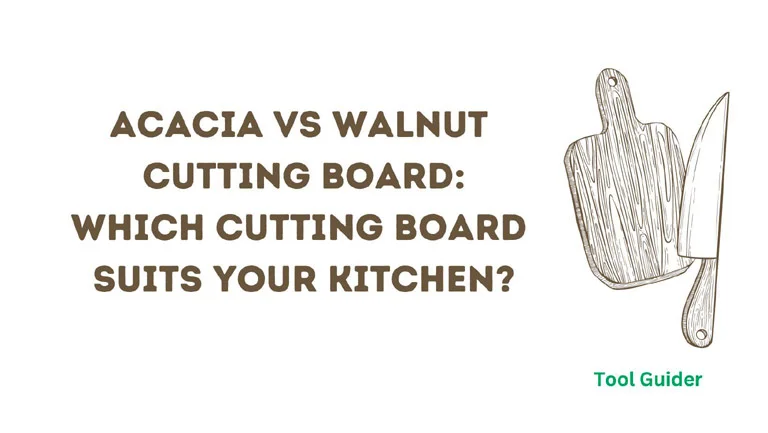Comparing between Acacia vs Walnut Cutting Board we will help you in choosing the perfect kitchen Companion for your culinary adventures. Each wood type offers distinct characteristics that can influence your decision.
Cutting boards made out of acacia are well known for their resilience and appealing grain patterns. Acacia wood is strong and resistant to cracking because to its thickness, which also eliminates knife marks. Acacia wood also has natural antibacterial qualities that help it be a hygienic surface for food preparation.
Cutting boards made of walnut have a rich, deep color that exudes elegance. Because of its durability, walnut wood is renowned to survive extensive use while preserving its look. By preventing bacterial growth, the natural oils found in walnut wood help to create a clean cutting surface.
Choosing the Right Cutting Board: Factors to Consider
- Durability: A durable cutting board will withstand regular use without easily showing signs of wear.
- Knife-Friendliness: The cutting board should be gentle on your knives to prevent dulling or damage.
- Hygiene: Look for a cutting board that is easy to clean and maintain.
- Size and Thickness: A larger cutting board can provide ample working surface, while a thicker board offers better stability.
- Maintenance: Different cutting board materials require different maintenance routines.
- Aesthetics: If visual appeal is important to you, consider the aesthetics of the cutting board.
- Budget: Determine a budget that aligns with your needs and preferences.
Pricing and Availability: Getting the Best Value under Budget
To make sure you receive the best cutting board for your money when buying one, it’s important to consider cost and availability into account. Remember that while cost is important, it is as necessary to think about the cutting board’s quality, durability, and functionality. Making a rational decision and choosing a cutting board that will work successfully for you in the long run require finding the right balance between value and quality.
Maintenance and Care: Acacia vs walnut cutting board
Acacia Cutting Board
- Regular oiling: Apply food-grade mineral oil or specific cutting board oil to the surface of the board every few months or as needed to keep it moisturized and prevent it from drying out or cracking..
- Hand wash only: Avoid soaking the board for extended periods as they are generally not dishwasher-safe.
- Regularly dry after cleaning: After washing, thoroughly dry the acacia cutting board with a clean towel and allow it to air dry completely before storing. Avoid leaving the board in a damp or wet condition, as it can lead to damaging or splitting.
- Avoid direct sunlight: Keep the acacia cutting board away from direct sunlight and extreme temperature changes, as these can cause the wood to warp or crack.
Walnut cutting board
- Periodic oiling: Apply specific cutting board oil to the surface of the board every few months to maintain its moisture and preserve the wood.
- Hand wash recommended: It is advisable to wash walnut cutting boards by hand using warm water and mild dish soap, instead of using a dishwasher. It is important to avoid soaking the board for prolonged periods and to ensure it is thoroughly dried after cleaning.
- Use a cutting board conditioner: some people goes for specialized cutting board conditioners designed specifically for walnut or other hardwoods. These conditioners are intended to nourish and safeguard the wood, preserving its quality and durability as time passes.
- Regular inspection and maintenance: regularly check the walnut cutting board for any signs of wear, scratches, or dryness.
Pros and Cons: Acacia vs walnut Cutting Board
Acacia Cutting Board
Pros
- Exceptional durability and resistance to knife marks.
- Natural antimicrobial properties for improved hygiene.
- Attractive grain patterns and warm color tones.
- Affordable and widely accessible.
- Harvested from sustainable sources and is considered an eco-friendly option
- Hygienic choice for food preparation and minimizes the risk of cross-contamination.
Cons
- Requires regular oiling and maintenance to preserve its appearance and durability.
- May develop scratches and wear over time, requiring occasional sanding.
- not suitable for those looking for a low-maintenance option
- Sensitive to changes in moisture levels.
- Some individuals may find the variations less desirable if they prefer a more uniform appearance.
Walnut cutting board
Pros
- Elegant and luxurious appearance with rich dark tones.
- Strong and durable, capable of withstanding heavy use.
- Natural oils inhibit bacterial growth.
- Provides an exquisite presentation for serving food.
- can withstand heavy use and provide a long-lasting cutting surface
- Offers a good balance between durability and knife-friendliness.
Cons
- Higher cost compared to other wood options.
- Dark color may make knife marks more visible.
- Less readily available compared to acacia or other common wood types.
- Some individuals may have allergies or sensitivities to walnut wood.
- Rich, dark color of walnut cutting boards can make scratches and signs of wear more visible compared to lighter-colored woods.
Conclusion
When it comes down to Acacia vs walnut Cutting Board explore which wood type aligns best with your needs. Both kinds of cutting boards have special qualities and advantages, whether you choose the durability and lovely grain patterns of acacia or the rich dark tones of walnut.
To make an informed choice, consider your individual requirements, budget limit, and preferred aesthetic. Whichever you decide, a well-kept cutting board will be a reliable and elegant asset in your culinary endeavors.

I love all things tech, and I wear many hats – tech lover, business starter, digital marketer, and blogger. I know the ins and outs of Digital Marketing, SEO, SEM, SMM, and how to generate leads. My goal? Making things simple for you with clear guides and reviews. I stumbled upon WordPress while creating my first business site, and I fell in love with it right away. When I’m not building websites, creating content, or boosting clients’ online efforts, I’m focused on staying healthy, hanging out with family, and exploring the world. Connect with me on Facebook, Twitter, Linkedin, or read my complete biography.

